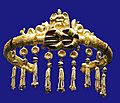Reef knot facts for kids
Quick facts for kids Reef knot |
|
|---|---|
 |
|
| Names | Reef knot, Square knot, Hercules knot, Double knot,brother hood knot |
| Category | Binding |
| Origin | Ancient |
| Related | Thief knot, Granny knot, Grief knot, Surgeon's knot, Shoelace knot |
| Releasing | Jamming |
| Typical use | Joining two ends of a single line to bind around an object. |
| Caveat | Not secure as a bend. Spills easily if one of the free ends is pulled outward. Does not hold well if the two lines are not the same thickness. |
| ABoK | #74, #75, #460, #1204, #1402, #2096, #2573, #2574, #2577, #2580 |
| Instructions | [1] |
The reef knot, also known as the square knot, is a very old and simple way to tie a rope or line around something. It's sometimes called the Hercules knot. You make it by tying one simple knot (an overhand knot) and then another one on top, but in the opposite direction. A good way to remember how to tie it is: "right over left; left over right." This helps make a neat and strong knot. If you tie two simple knots the same way, you'll get a granny knot instead, which isn't as good.
The reef knot is not the best choice for joining two ropes together. This is because it can come undone easily, especially if the ropes are not the same thickness or if they are pulled in certain ways. Because of this, it's important to use the right knot for the job, especially when safety is important.
Contents
What the Reef Knot is Used For
The reef knot is great for tying the ends of a single rope together. It helps to secure things that won't move around much. For example, you can use it to tie up a bundle of items.
In Sailing and Crafts
Sailors use the reef knot to tie up sails when they are not being used. This is called reefing or furling sails. It's also a very important knot in macrame, which is a type of textile art made by knotting cords.
In Medicine and History
This knot lies flat when made with cloth. Because of this, people have used it for thousands of years to tie bandages. The ancient Greeks knew this knot as the Hercules knot. It is still used a lot in medicine today. An ancient writer named Pliny even wrote that people believed wounds would heal faster when tied with a Hercules knot.
For Belts and Shoelaces
Since ancient times, people have used the reef knot to tie belts and sashes. Today, you might see it used to tie the obi (or belt) of a martial arts uniform, like a keikogi.
You can also use a special version of the reef knot to tie your shoelaces. If you tuck the ends in, it makes a quick-release knot. The regular version is good for shoelaces that are too short. It's also useful for tying plastic garbage bags, as the knot forms a handle.
In Scouting
The reef knot is very important in Scouting all over the world. It is part of the international membership badge. Many Scouting awards also feature it. In the Boy Scouts of America, learning to tie the square knot correctly is a requirement for joining the program. In Pioneering (Scouting), it helps finish off special lashing (ropework) and whipping knots. However, remember it's not strong enough to hold heavy weight.
Surgeon's Knot Variation
A special version called the surgeon's variation is used when you don't have an extra hand to help. It's made with two or three twists of the ropes instead of just one.
Related Pages
Images for kids
-
A statue from Ancient Egypt (2350 BC) showing a reef knot on a belt.
See also
 In Spanish: Nudo de rizo para niños
In Spanish: Nudo de rizo para niños






